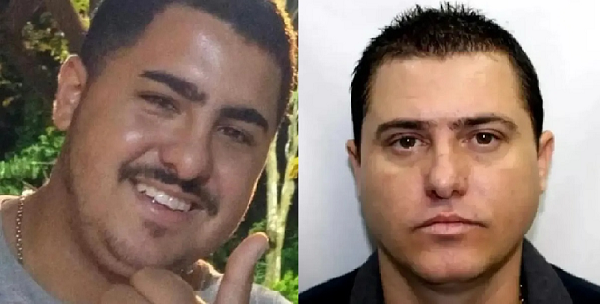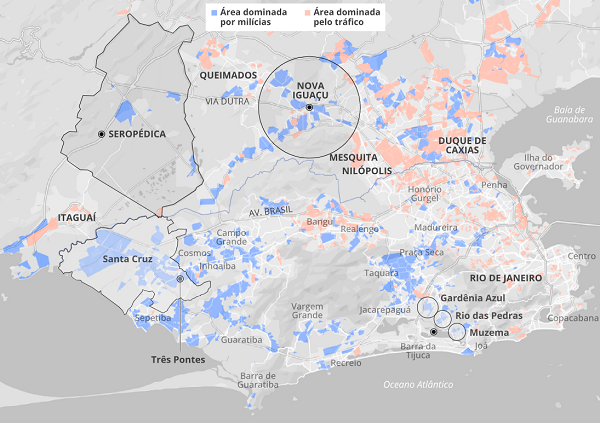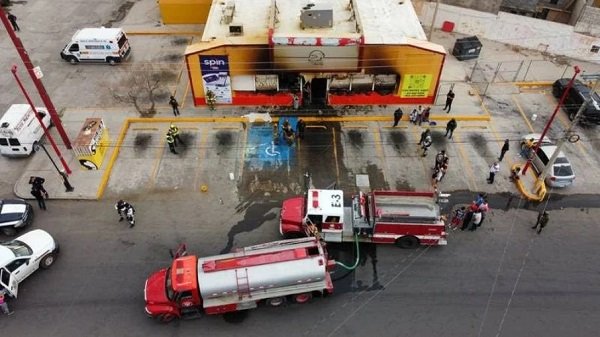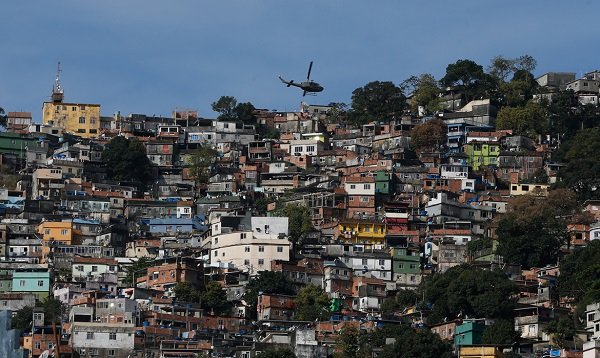Summary
Recent cases of violence – with acts of vandalism, shootings, and the murder of innocent people – have been plaguing Rio de Janeiro. Changes in geography and behavior of the militia and drug trafficking explain this increase in violence. In addition to the deaths of innocent people, this affects the image of Rio de Janeiro and Brazil around the world, in addition to increasing violence and risks for companies that operate here.
New Cases

On 23 October the West Zone of Rio experienced another episode of violent clashes between criminal groups and the police. More than 35 buses, in seven neighborhoods of the West Zone, were targets of arson. The fires were allegedly set by militiamen in retaliation for the death of Matheus da Silva Rezende during a shooting with officers, on the same day. Known as Faustão, he was the nephew of Zinho, head of one of the main militias in the region. He was considered the second man in the militia hierarchy and would be the main person in charge of disputes between rival bands in the West Zone.

According to experts, the events are related to militia activities in poor areas and recent changes in the geography and behavior of organized crime in Rio de Janeiro. Paramilitary groups originally created by police officers, the militias dominate dozens of communities in the West and north Zones of the capital, in addition to Baixada Fluminense and in cities in the eastern region of the state, such as São Gonçalo and Itaboraí. In recent years, some of these groups have split and joined trafficking, which has even changed their way of acting. The violent attack against public transport – the largest known in the State – was a common practice of drug traffickers and are new to militiamen.
The Various Sides of the Same War
Organized crime in Rio is divided between drug trafficking and militias. According to a study by the Study Group on New Illegalities at the Fluminense Federal University (Geni/UFF), the biggest are:
- Red Command (CV). The most powerful drug faction in Rio, with branches throughout Brazil, dominates vast areas in the South and North Zones — such as Rocinha, Complexo do Alemão and Cidade de Deus. According to Geni/UFF, with data from 2022, there are 2 million people under its yoke.
- Pure Third Command (TCP). Dissent from the extinct Third Command — opposed to the CV — became the second largest group of drug traffickers in Rio, says Geni/UFF. Among its largest bases are Complexo de Israel, in Cordovil, and Complexo da Maré. The TCP created a partnership with the militia precisely to try to confront the CV.
- Friends of Friends (ADA). Trafficking faction in decline, currently not involved in disputes.
- Militias. Unlike CV, TCP, and ADA, they do not have a unified leadership, but they have multiplied, and, on the Geni/UFF map, they have surpassed the drug factions, combined, in territorial area: 256 km² — where 1.7 million people live. Each region has its own leadership, but there was a non-aggression pact between the militias. The biggest of them is the one derived from the Justice League, which rules over a large part of the West Zone of Rio and Baixada Fluminense.
Conflagrated Cores
There are five regions currently in conflict:
- Greater Barra da Tijuca (Anil, Barra da Tijuca, Cidade de Deus and Gardênia Azul): Red Command against Militias allied with Third Pure Command
- Greater Jacarepaguá (Água Santa, Campinho, Praça Seca, Quintino, Tanque and Taquara): Red Command against Militias
- Grande Penha (Brás de Pina, Cordovil, Parada de Lucas, Penha Circular and Vigário Geral): Red Command againts Third Pure Command
- Baixada Fluminense — there are two areas: Km 32 (Nova Iguaçu), between Red Command and Milícias, and Morro da Torre (Queimados), with Red Command against Third Pure Command.

No Distinction Between Militia and Drug Trafficking
Originally, drug traffickers and militiamen differed in the fact that traffickers competed for drug sales points while militiamen prohibited the use of narcotics in their areas. In turn, the militia charged a protection fee in addition to imposing a monopoly on clandestine internet services and water and gas distribution, on which taxes were levied.
According to the police, there is no longer a distinction between militia and drug trafficking, because both imitate each other’s business models — which may have been a driving force behind the escalation of deaths and other violent crimes in recent months.
Red Command (CV), a criminal faction originally focused on drug trafficking, is now allied with militiamen from the West Zone to control communities in the region. Having control of an area means being able to explore the illegal trade of drugs and products and services, such as the sale of bottled gas, internet access, transportation by van and others — now carried out by militiamen and drug traffickers, without distinction.
In October, other episodes related to the intensification of these conflicts in the West Zone included the triple murder of orthopedics physicians from another Stat on the Barra da Tijuca beach and the diversion of weapons from a military arsenal in São Paulo.
The Murder of the Doctors
Four orthopedic physicians were shot in the early hours of 5 October at a kiosk in Barra da Tijuca beach, Rio de Janeiro’s West Zone. Three died. The victims, from another state, were in the city for an international orthopedics conference. They were staying at the Hotel Windsor, on Avenida Lúcio Costa, which hosted the 6th International Congress of Minimally Invasive Foot and Ankle Surgery.
Due to the fact that one of the victims, Diego Bomfim, was the brother of federal deputy Sâmia Bomfim (PSOL-SP), the police initially considered the hypothesis of a political crime. However, throughout the day, the police’s main line of investigation became that doctor Perseu Ribeiro Almeida had been mistaken for a militiaman, Taillon de Alcântara Pereira Barbosa. The militiaman lives on the same avenue where the doctors were murdered. Since last year, Taillon and other members of the Rio das Pedras militia have become enemies of the gang that dominates Gardênia Azul — a group formed by former militiamen who, since last year, have allied themselves with drug traffickers from the Red Command (CV).

The pact between the criminals took place amid a process of fragmentation of Rio’s militia, which was triggered by the death of Wellington da Silva Braga, known as Ecko, during a Civil Police operation in 2021. The fall of the boss triggered a series of internal conflicts within the militia in several neighborhoods in the West Zone and the Baixada Fluminense. The CV took advantage of the fragility caused by rivals‘ disputes and began trying to invade former militia domains, such as Gardênia Azul — which ended up leading some of the local militiamen to join the faction.
The conflict has already caused several deaths in the region, such as that of Leandro Siqueira de Assis, known as Gargalhone, one of the former militiamen who joined the drug trade, found dead in a car in front of Mercado do Peixe, also in Barra da Tijuca, in May. Tthe vehicle used in the crime was later tracked in Cidade de Deus, a favela in Jacarepaguá dominated by the CV.
On 5 October, four drug dealers suspected of participating in were found dead on the outskirts of Gardênia Azul. According to the police, they were killed by their own faction, after having killed the doctors by mistake.
Theft of Army Weapons
Another important event was the theft of 21 firearms from the Army Arsenal in Barueri, in Greater São Paulo. According to the army, during an inspection carried out on 10 October at its War Arsenal, the military noticed the disappearance of thirteen .50 caliber machine guns and eight 7.62 caliber machine guns. All the weapons taken were not operational but could undergo maintenance. This was the largest diversion of weapons recorded by the Brazilian Army since 2009, when the Sou da Paz Institute began carrying out this type of survey.
The 21 large-caliber machine guns stolen from the Barueri barracks, in Greater São Paulo, were offered to the CV, in Rio de Janeiro. Media sources found that the RJ Civil Police had access to a video with the image of four machine guns being displayed to a potential buyer from Rio. According to investigations, the weapons offering took place after the 7 September holiday. The group that stole the machine guns asked for R$180,000 for each gun. The offer for the guns was made to drug dealer William de Souza Guedes, known as Corolla, a criminal who currently commands the Manguinhos Complex, in the North Zone of Rio and is one of the trusted men of the leaders of the Red Command (CV) faction.
Eight of the 21 Army machine guns that were stolen from the Barracks War Arsenal in Barueri, in São Paulo, were found on 19 October at the entrance to Gardênia Azul, West Zone of Rio. The seizure of 4 .50 machine guns and another 4 MAGs, caliber 7.62, were made by agents from the Narcotics Suppression Police Station (DRE), of the RJ Civil Police, with support from Army Intelligence. No one was arrested. They would be used in the dispute between factions that has been terrorizing the Jacarepaguá region for almost a year.
The Conflict in Numbers
The conflict between criminal groups has generated an escalation of violence with several deaths and severe injuries in the West zone in recent months. The effects already appear in violence statistics.
A survey by the Fogo Cruzado Institute showed that, from 1 January to 20 October 2023 (when the count was closed), there were: 241 deaths in homicides in Rio’s West Zone – an increase of 129.5% over the 105 deaths in the same period of 2022, including 13 massacres that left 47 people dead – an increase of 291.6% over the 12 deaths in 4 massacres last year and 728 shootings – 55.88% more than last year’s 467.
When we look specifically at the seven neighborhoods where militia attacks on buses occurred, we observe that there was an explosion in homicides this year, compared to last year. In the areas where the Santa Cruz, Campo Grande, Recreio dos Bandeirantes and Guaratiba police stations operate, 140 people were killed between January and September this year, representing an increase of 57% compared to the same period last year, according to data from the Security Institute Public (ISP). Deaths in confrontations with the police also increased in these areas: 14 incidents in the first nine months of this year, compared to six in the same period last year.
Violent deaths in the Jacarepaguá and Barra da Tijuca area affected general violence indicators in the Southeast Region and the country. According to the G1’s Violence Monitor, homicides fell 3.4% in Brazil in the first half of 2023, compared to the same period last year. The drop occurred in almost all regions. The exception was the Southeast, where murders increased. In the region, the biggest increase occurred precisely in Rio de Janeiro: 17.3%. And we can see that the increase occurred more in the West Zone of the capital and in some municipalities in Baixada Fluminense.
Impact on Business
The impact of crimes such as the brutal murders of the three orthopedists who were in Rio for a conference this week is undeniable, agree businesspeople, authorities, and sector experts.
The problems caused by violence in Rio de Janeiro directly affect the city’s and the country’s attractiveness for investors, qualified professionals, companies and even their ability to increase investments in strategic sectors, such as infrastructure, education, and health. Crimes also generate costs – with security, health, insurance, extra planning, losses, etc. –, increasing financial risks and reducing profits.
An example is the case of Light, one of the largest energy distributors in the country and which has filed for judicial recovery. It serves 4.5 million users in Rio de Janeiro, the sixth largest consumer market in this segment. However, 20% of its coverage area is in areas dominated by drug trafficking and militia.
In some areas, such as the West Zone, the militia even makes connections in their real estate projects using Light’s energy and charging the end consumer as if they produced the energy. In areas where the connection comes from the distributor, the militia charges an additional fee, which ends up encouraging the customer to give up the official service.
The losses imposed on the company by organized crime are the most glaring aspect of the energy distributor’s extensive debt, which led the holding company to file for judicial recovery.
Risk of “Mexicanization” of Rio de Janeiro
The transformation of Rio into a Brazilian version of Ciudad Juarez, a Mexican city marked by high mortality rates, with torture and decapitation of citizens and wide penetration of the State by organized crime, is a possibility that surrounds debates amongst Brazilian security professionals.

Rio de Janeiro has not yet reached this level of lack of control, but the scenes of 23 October, when militiamen set fire to buses with passengers, generated warnings. In Mexico, there are regions or provinces where you cannot enter without authorization from the cartels. Today in Rio de Janeiro there is already something similar on a smaller scale. You can’t enter in the favelas without militia or drug trafficking authorization. So, there is a process of ‘Mexicanization’. In addition, militia members usually support candidates to local elections, in the same way as drug traffickers do.




